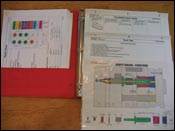Across the Bench: Let the Run Begin
Setup checklists, verifications and injection mold layout sheets are critical factors in the beginning of the mold process.
Regardless of mold type, the goal of a maintenance shop always is the same: get a mold production-ready after it has been removed from service. Given today's climate, with manufacturing jobs migrating to foreign soils faster than we can flash a parting line, the objective can no longer be only getting the mold ready. To stay competitive, mold maintenance needs to be more effective and perform faster, using less tooling and fewer man hours. Accomplishing this does not require magic, expensive technology or complicated systems. Instead, it depends on communication, accurate historical data, sound workmanship and continuous training.
Mold builders and designers keep a close eye on maintenance issues that surround their molds. Like any service provider, they want their molds to run reliably and efficiently with maintenance costs held to a minimum. This keeps customers coming back. If duplicate molds or components are to be built, accurate mold history can help designers and builders improve their designs and construction methods. Mold evolution is based on performance evaluations and maintenance requirements as much as technological wizardry.
Beginnings We will start with a thirty-two-cavity, hot runner cap mold (2004 Quarter Cap) that has been set in the press and is waiting to be fired up. First of all, you need to have a setup checklist to ensure all steps are implemented correctly and consistently. While the mold reaches operating temperature, the process technician runs through his setup sheet to verify all mold parameters are set correctly. Then, the molding process begins. After the process has stabilized, a shot is checked and released by Q/A and the run/repair cycle is underway.
Injection Mold Layout Sheets
At this time, the process technician documents specific information on an injection mold layout (IML) sheet, such as start date, time, starting technician and press number. If the mold is hard to start or fillout, flashes easily or suffers other process issues, these observations are documented on the IML sheet for toolroom evaluations.
The IML sheet is a critical factor in the information chain. In sequential order, it documents mold, part and other related performance issues that may arise during a typical production run. Whenever part of the run/repair cycle is not documented accurately, generalized sweeping statements like "it has never done that" or "it always does that" need to be quantified and can drastically skew a root cause analysis.
Figure 1 is an example of a completed IML sheet. All critical information for an effective repair has been documented. Q/A or processing discovered defects have been blocked off and noted. All that remains is for the last shot to be visually inspected for flash and other abnormalities. If quality issues are found, they will be noted in the repair plan. It is helpful to have a separate last shot sheet for recording flash lengths and other visual observations for multi-cavity molds.
Also included on the sample IML are a mold map and sign-off area for technicians performing in-press servicing. The frequency and depth of in-press cleaning is dependent on mold and process characteristics that dictate residual contamination levels. It should be the goal of every shop to set in-press and out-press cleaning frequency standards, based on the amount of internal and external residue contamination a mold exhibits after a certain number of cycles or hours run.
When the decision is made to pull the mold, a last shot of all remaining parts is gathered for inspection along with samples of any block-offs and forwarded to the toolroom supervisor for disposition.
IML Importance
Some companies can enter data at the press through PCs, but generally the information is limited and takes too much time to type in from a small hand-held, palm-sized computer. Collecting IML-type data manually is easier, quicker, more accurate and readily accepted by most maintenance personnel.
Even if your typical production runs are short and there are no issues to worry about, mold run data still needs to be documented for sequential accuracy. Molds that are run, pulled and racked without any collected data leave voids that complicate everything from troubleshooting defects to tracking what lots/parts the mold ran during any given timeframe.
As you can see there are only a few steps to starting a mold and collecting accurate, usable data needed for a repair plan. The most difficult part of collecting performance data at the press is acquiring the discipline to use and manage an IML sheet. The toolroom supervisor needs to work with the molding supervisor to systemize the approach and share IML responsibility. Repair technicians must know how a mold performs before corrective actions and improvements can be implemented effectively.
Next month I will discuss creating the repair plan. Stay tuned.
Related Content
How to Overcome Complex Mold Texturing Problems
Key benefits when considering laser technology for mold texturing and repair.
Read MorePortable Low-Heat, Non-Arcing Resistance Welder for Mold Repair
Rocklin’s user-friendly MoldMender Micro Welder delivers simple and cost-effective localized repair in-house with precision and versatility, enhancing mold and die durability and reducing disassembly and downtime.
Read MoreHow to Use Thermal Management to Improve Mold Cooling
A review of common mold cooling issues and possible solutions, including 3D printing applications.
Read MoreThink Safety: Eliminate Hazards Throughout the Shop
The tooling community is taking advantage of new products for safer mold shops and molding facilities.
Read MoreRead Next
Maintenance Manuals That Work
Organized maintenance manuals can offer an advantage that electronic data does not.
Read MoreHow to Use Strategic Planning Tools, Data to Manage the Human Side of Business
Q&A with Marion Wells, MMT EAB member and founder of Human Asset Management.
Read MoreHow to Use Continuing Education to Remain Competitive in Moldmaking
Continued training helps moldmakers make tooling decisions and properly use the latest cutting tool to efficiently machine high-quality molds.
Read More




















